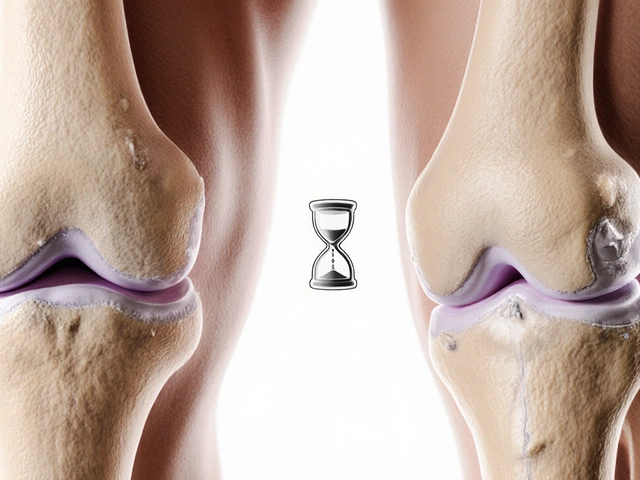Stuck between seeing a therapist or a psychiatrist? This article strips away confusion and helps you decide which route fits your unique mental health needs. We’ll break down what each professional does, when to pick one over the other, and how your first session might actually look. Real talk about costs, common worries, and practical tips included. Finally figure out what actually works for your situation.
Read MoreTherapy Guides for Pain-Free Living in India
Feeling stuck with aches, stress, or post‑operation discomfort? You’re not alone. Below you’ll find straightforward therapy ideas that actually work, whether you prefer ancient Ayurvedic tricks or modern rehab plans. These tips pull from real‑world experiences and the latest Indian health insights, so you can start feeling better today.
What Is Therapy in Pain Management?
Therapy isn’t just a word for talking to a counselor; it covers everything that helps your body or mind heal. In the Indian context, it can mean herbal blends, guided breathing, targeted exercises, or even a well‑planned diet. For example, the post on Ayurveda Inflammatory Foods shows how swapping hot, dry items for cooling, moist foods can calm joint flare‑ups. Likewise, the guide on Key Questions to Ask Your Orthopedic Doctor teaches you how to get the right physical therapy plan after a fracture.
When you combine these approaches—nutrition, movement, and professional support—you create a multi‑layered defense against pain. The result is less reliance on strong meds and a more sustainable, comfortable life.
Top Therapy Approaches You Can Use Today
1. Ayurvedic Lifestyle Tweaks – Start your day with warm water and gentle stretches aligned with your dosha. If you’re a Vata type, warm soups and grounding activities keep you steady. The Vata Personality Traits article gives simple daily habits you can copy.
2. Targeted Exercise Programs – After knee replacement, pain usually eases within weeks if you follow a slow‑progress plan. The knee replacement timeline post explains milestones like walking without crutches by week three. Even a short daily walk, as detailed in the “Does Walking Burn Belly Fat?” piece, can boost circulation and lower stiffness.
3. Mind‑Body Practices – Managing chronic back pain often starts with knowing the right specialist. The “What Is a Back Doctor Called?” guide helps you locate a spine expert, while the mental health article on treatable illnesses reminds you that anxiety and depression can magnify pain, so CBT or simple relaxation drills are worth trying.
4. Smart Supplement Choices – Not all pills are created equal. The “5 Main Types of Supplements” article breaks down vitamins, minerals, herbs, proteins, and specialty blends, so you can pick what your body truly needs without overloading.
5. Professional Medical Support – Sometimes you need a doctor’s advice fast. The post “Is It Safe to Get Prescriptions Online?” warns about hidden risks and tells you when a tele‑consult is fine versus when you should visit a clinic.
Pick the tips that match your lifestyle, try them for a couple of weeks, and adjust as you feel better. Therapy is personal, so experiment, listen to your body, and don’t hesitate to ask a health professional for guidance.
Ready to take control of your pain? Start with one small change today—whether it’s a new breakfast swap, a five‑minute stretch, or a quick chat with a specialist. Consistency beats perfection, and every step moves you closer to a pain‑free life.
Explore the most profound forms of mental health therapy that delve deeper than traditional methods. Discover how these therapies uncover root causes of emotional pain and foster genuine healing. Learn about intriguing techniques that transform the way we think about our mental well-being. This article sheds light on therapies designed to reach the heart of psychological distress.
Read MoreAdult ADHD isn’t just about losing focus or being forgetful; it carries challenges like impulsivity, emotional turmoil, and relationship strains. Understanding its underbelly can shine a light on the invisible struggles faced daily. This article unfolds the complexities while offering practical tips to manage these darker aspects. Let's untangle the reality of living with ADHD in adulthood.
Read MoreAnxiety disorders are the most diagnosed mental health condition globally, affecting millions of people. This article delves into what it means to live with an anxiety disorder, including its symptoms, potential causes, and treatment options. Readers will also find some practical tips for managing anxiety in daily life and insights into the latest research on the disorder.
Read MoreMany people wonder about the scope of sharing in therapy sessions with their therapists. Is there such a thing as sharing too much? This article explores the idea of oversharing in the therapeutic context, highlighting important considerations like trust, boundaries, and personal comfort levels. We seek to understand the dynamics between client and therapist and how to foster a productive and safe therapeutic environment.
Read MoreDysthymia, a persistent depressive disorder, often flies under the radar despite its profound impact on everyday life. Characterized by a chronic low mood lasting for years, it can be misinterpreted as mere pessimism or a negative outlook. Unlike episodic depression, dysthymia subtly infiltrates day-to-day living, making it challenging to diagnose and often goes untreated. Increasing awareness and understanding of dysthymia’s symptoms is crucial for proper diagnosis and therapy.
Read MoreLiving with severe mental illnesses can be an excruciating experience that impacts every aspect of life. The severity and pain of mental illnesses like depression, bipolar disorder, and schizophrenia are often indescribable, leaving those affected feeling isolated. Understanding these conditions helps in providing proper support and finding effective therapy options. This article delves into the symptoms, challenges, and coping mechanisms associated with the most painful mental illnesses.
Read MoreTherapists often pay attention to a client's hand movements during sessions as these gestures can reveal a lot about a person's emotions and thought processes. Observing hands may provide clues to hidden emotions or unresolved conflicts that verbal communication might not capture. Understanding these nonverbal signals can enhance the therapy process, making it more effective for both the therapist and the client. By reading body language, therapists gain a more comprehensive understanding of their clients, which aids in identifying subconscious feelings and states.
Read More











